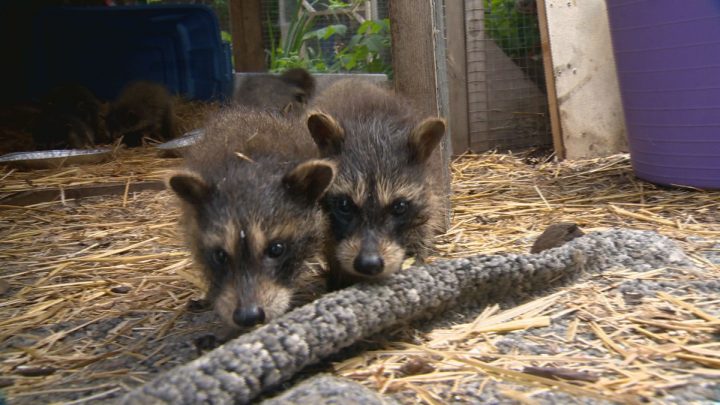For about four months out of the year starting in spring, Hayley Hesseln’s life revolves around taking care of orphaned or injured raccoons.

“It’s just a tremendous amount of work, but it’s so worth it,” she said.
In 2013, the University of Saskatchewan professor started Bandit Ranch Rehab out of her own home.
“They start in my house from tiny babies sometimes fitting in my hand – one or two days old – to going into my garage where they are in bigger pens and then out to the pen,” she explained.
Hesseln is the only raccoon rehabber in Saskatchewan. Currently, she’s looking after a record 68 little critters.
“People are not willing to live with them – they’re not tolerant,” she said. “They’ll shoot the mothers or drown the mothers and then they feel sorry for the babies.”
Hesseln said some days can be overwhelming. The little ones are bottle-fed five times per day and then there are those who are weening.
“I boil eggs for them about two-and-a-half dozen every couple of days – I cook chicken for them chop it up, get the fruit chop that up.”
She noted managing this many raccoons wouldn’t be possible without the help of volunteers who spend hours every day to help with the feedings.
Wildlife rehabilitators caution others, however, against keeping them as pets.
“At a certain age they get wild and they have certain behaviours that are really not adaptable to a household,” Living Sky Wildlife Rehabilitation executive director Jan Shadick said.
“Most raccoons will have some sort of an internal or external parasite going on and you don’t generally want that in your house.”
- Budget 2024 failed to spark ‘political reboot’ for Liberals, polling suggests
- Train goes up in flames while rolling through London, Ont. Here’s what we know
- Peel police chief met Sri Lankan officer a court says ‘participated’ in torture
- Wrong remains sent to ‘exhausted’ Canadian family after death on Cuba vacation
“Even the tamest ones I’ve had will start growling they don’t want to be picked up,” Hesseln said.
When the little bandits are about six to eight pounds and prepared to survive on their own, Hesseln will let them go – typically in rural areas where they’ll be accepted.
“That’s where they become quite wild, they don’t see people that often, they become nocturnal and about the end of September is when we release them in small groups,” Hesseln explained.
While raccoons are largely considered a pest, wildlife rehabilitators say people need to figure out a way to live with them.
“Raccoons are amazing which is part of why we love them and why we hate them, because they have hands and they can get into everything,” Shadick said.
Some effective deterrents include bright lights, noise, or an ammonia-soaked rag.
If problems persist, call someone who knows how to manage them.
“I think we need to be more compassionate and humane,” Hesseln said.




Comments